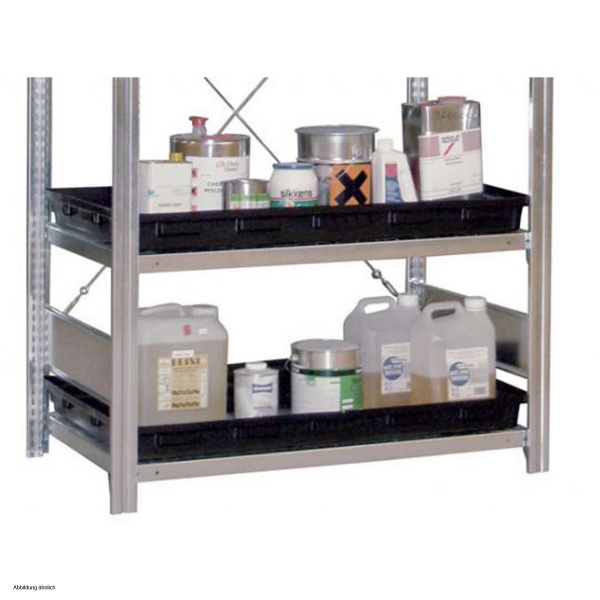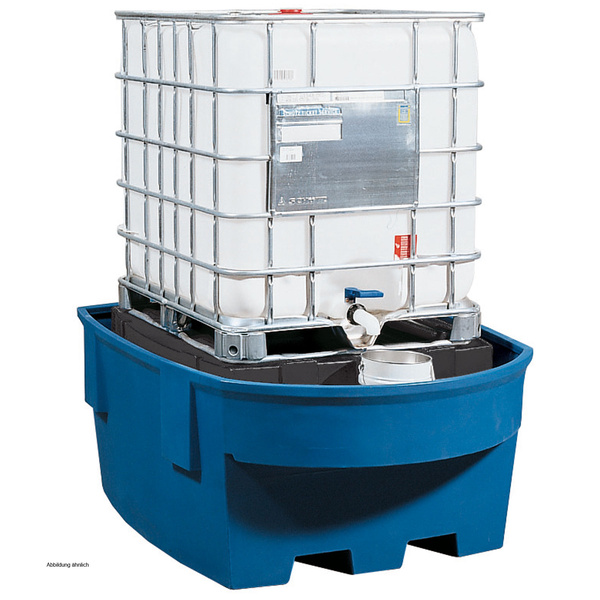Laboratory Sump Pallets, Containers
Manufacturer for Sump Pallets, Containers
Laboratory collection trays for the highest requirements
In our online shop for laboratory supplies, you can order collection tra ys from various manufacturers for almost all requirements. We offer containers & drip trays for the transport and storage of chemicals, acids, alkalis, oil, flammable liquids and other hazardous materials. When choosing a sump for your requirements, you should consider a few criteria.
Separate collection trays are not only necessary in the laboratory, chemical industry, food industry or car workshop to collect liquids that may be used again and to prevent contamination of the floor.
In many areas of application, drip pans are mandatory and subject to certain legal regulations & guidelines. A drip tray is a safety measure for collecting hazardous substances and is primarily used for the storage and transport of substances hazardous to water (VAwS), which must not enter water bodies or seep into the ground.
The legal necessity of catchment tanks, sumps & containers in laboratories or other areas is prescribed by the Water Resources Act (WHG). StawaR is the guideline on the requirements for steel drip pans with a volume of up to 1000 litres, which are primarily used in industrial and commercial storage facilities as well as in the various laboratories.
Drip trays: optimal testing & marking
Laboratory collection trays manufacturers must comply with certain DIN EN ISO standards and provide evidence of qualifications when manufacturing the trays, depending on the requirements. The initial test is carried out by a recognised test centre and is documented in a test report. During the factory inspection of production, a construction, weld seam and leak test and corrosion protection check (not for stainless steel) must be carried out on each collection tray (made of steel).
The following data must be permanently marked on the sump: manufacturer, year of manufacture and serial number, material and load-bearing capacity of the sump/grate, collection volume, if applicable, information on use in accordance with StawaR and Ü mark. On the part of the user and operator, there are of course also numerous regulations for the proper installation, use, maintenance and periodic inspection of the collection tray and, if applicable, the grating.
Drip tray: material & coating
The choice of the right material for your collection tray for use in the laboratory depends first and foremost on the substances that come into contact with the tray and the loads that act on it - its resistance to external influences such as pollutants, pressure, heat, cold, moisture or light and whether the material can be cleaned without leaving residues. Most sump trays are made of plastic (PE / GRP) or steel or stainless steel.
Sump trays made of polyethylene (PE)
Trays made of polyethylene (PE) usually offer high resistance to most alkalis, acids, oils and other aggressive hazardous substances. Essentially, they are not suitable for petrol, diesel and other flammable liquids.
Galvanised drip pans
Steel dr ip pans are approved for the storage of water-polluting substances and flammable liquids. Painted or galvanised steel drip pans can also be used for waste oil, heating oil, diesel, petrol and many alkalis. Acids, on the other hand, attack the material.
Sump trays made of (V2A) stainless steel
Collecting traysmade of (V2A) stainless steel offer a very high resistance to particularly aggressive media, chemicals and highly flammable liquids.
Sump trays made of glass-fibre reinforced plastic (GRP)
As an alternative to conventional steel sumps, glass-fibre reinforced plastic (GRP) sumps can stand directly on the floor and are corrosion-resistant.
Drip tray: grating & trafficable
Depending on the area of application and type, the trays require a grating. We offer sumps with and without grating. We also have a wide range of models with removable grating made of galvanised steel, GRP, PE or PE pallets. You can order a grating as an option at any time.
Many of the sump trays can also be driven over. Mobile sumps make it possible to protect the drums from damage or dirt during transport. In addition, many of the drip trays on offer have base feet, drive-in pockets, skids, castors, forklift shoes or forklift pockets for easy transport of the trays by hand, forklift truck or forklift.
Drip tray: size, collection volume & shelf
The size of the collection tray depends directly on the respective area of application in the laboratory or company. Basically, the legislator requires a certain necessary collection volume of the trays.
According to this, the collection tray storage must be able to hold the contents of the largest container, at least ten percent of the storage quantity. In water protection areas, for example, the entire volume of the stored quantity, i.e. 100 %, must be able to be retained. We currently offer sizes from 60 l to 1000 litres (IBC) or larger.
If the collection tray is to be installed in a shelf for hazardous substances, the options for fastening and dimensions of the hazardous substances shelf must be taken into account. The tray must adequately cover the area in the hazardous zone. It is advisable to use several smaller trays, as these can be replaced more quickly, or to buy a customised drip tray.
Laboratory drip trays: Accessories at ProfiLab24
Our robust and tested collection trays from proven manufacturers are characterised by their reliability and safety as well as the possibility of replacing individual parts or adding accessories. Depending on the tray system and manufacturer, you can order various spare parts and accessories for your collection tray at low prices, such as different drums, pallets, grids, drum trolleys, containers, insert trays, can carriers, castors, feet and many other components and accessories for the trays on offer.



























